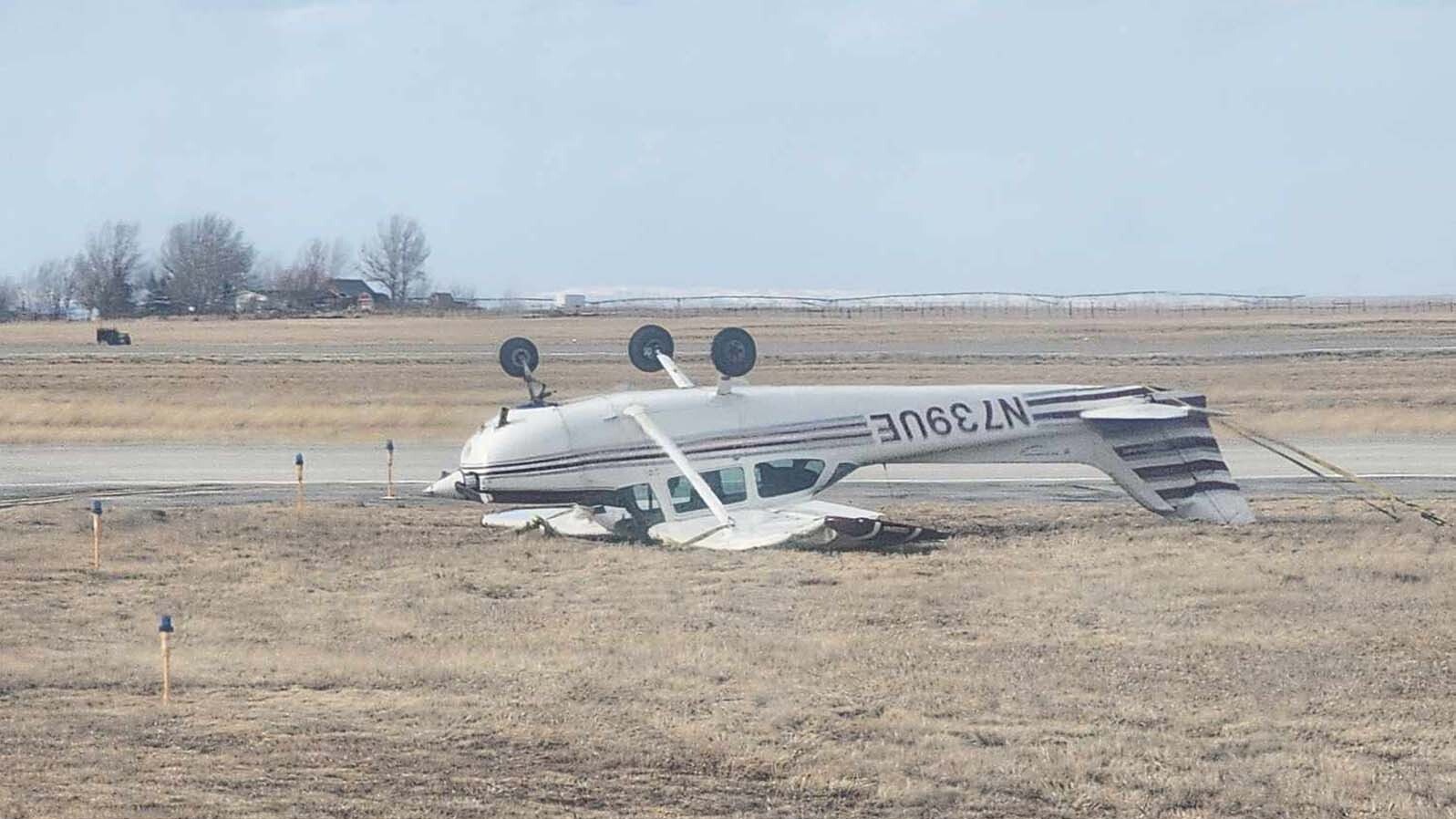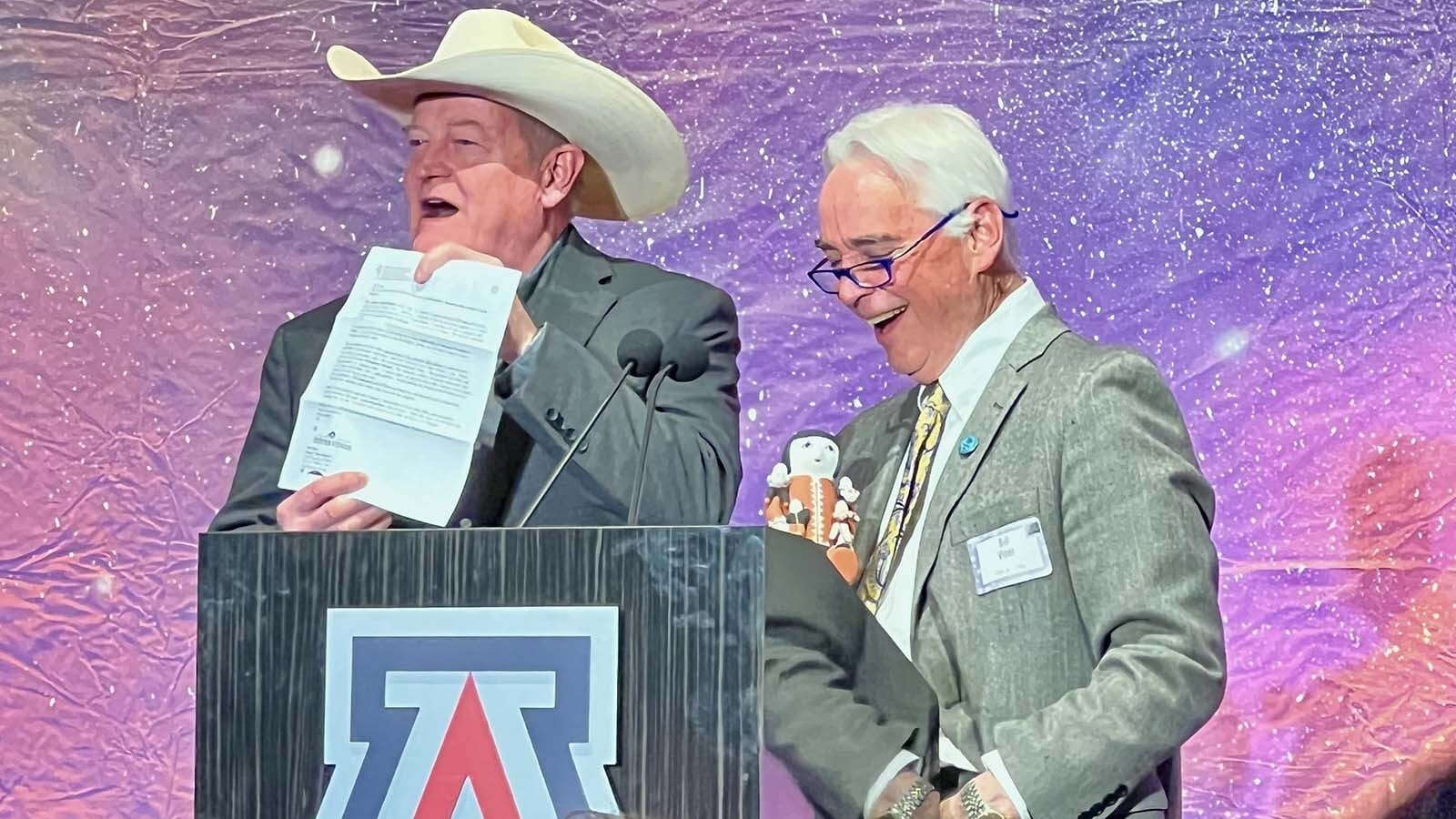CASPER — Wyoming’s famous winds have been whipping up a storm the past few days, making it difficult for high-profile vehicles to drive without the threat of being toppled.
For pilots navigating planes through gusts that exceed 60, 70 or even 80 mph, it can get downright dangerous.
The pilot of a single-engine Cessna 172 found that out the hard way Monday afternoon when it was flipped onto its roof by a gust after landing.
There was only one person on the plane, the pilot, who wasn’t hurt, said Tim McIntire, who works in the Casper/Natrona County International Airport Public Safety Department.
He had landed and was taxiing and making a turn when the wind just caught it wrong, he said.
And in a state known for its bluster, that’s not an uncommon happening, McIntire said.
“No, you see them get blown off the runway sometimes,” he said. “I can’t say in my career I’ve been working when one has flipped. Well, now I have. It happens. Generally, aircraft like that don’t fly when they have those types of wind. But what do you do when there’s no wind when you take off and it picks up while you’re (in the air)?”
The private aircraft flipped over about 12:45 p.m., and the FAA and National Transportation Safety Board are investigating the incident.
A check of the FAA registry shows the aircraft is a Cessna 172N that was manufactured in 1978.
Some Places Grounded
Commercial flights at the airport were operating on schedule, which is more than Denver International Airport could report. As of Monday afternoon, all commercial aircraft there were on “ground stop,” McIntire said.
A check with flying school in Cheyenne had planes grounded for the day due to the windy conditions. But Business Aviators in Casper took care of business as usual.
“Most commercial aircraft, airplanes that are over 10,000 pounds, really don’t have much trouble with days like today because they’re heavy enough and (use) big airports with a crosswind runway,” said Beech Strube, owner and director of operations at Business Aviators. “If you have been in Wyoming long enough, you know it’s not uncommon to have 60-70 mph of wind. I assure you that people with commercial airlines aren’t worried too much about the wind.”
Turbulence
Strube said the winds that have been blowing across the state may pose some challenges with turbulence, but for commercial pilots are “certainly doable and doable safely.”
His business, which manages eight aircraft, had two flights in the air.
The challenge comes for smaller aircraft. Private aircraft and trainers typically stay on the ground during high winds because the aircraft don’t have the mass to manage the wind very well, Strube said.
Pilots in Wyoming face crosswinds many months of the year and Strube places wind behind snow, ice, and thunderstorms in terms of the challenges and safety concerns they have to navigate.
Cowboy State Daily meteorologist Don Day said the weekend winds in Wyoming are typical for this time of year. He said challenges for pilots during the winter often involve turbulence.
“Downwind of Wyoming’s mountain ranges we get these rotors, or wave features, that form on the downwind side of the mountains that just cause a tremendous amount of turbulence,” he said. “It’s kind of like water over a rock in a brook.
“There is always going to be especially in the colder times for the year there is always going to be some type of turbulence in Wyoming even on the good days.”
Day said from November through April in Wyoming, high wind events of 60-70 mph are common.
“You are probably going to average one to two times a month, sometimes three where you have winds be that strong,” he said. “This year we have not had as many high-wind events like we had in 2022 and 2023.”
On Monday, Strube said his check of conditions showed just one aircraft in the Wyoming region that reported severe turbulence. When that happens, pilots will try to avoid the area.
“But at any given time, there are 10,000 airplanes in the air over the U.S., and certainly some of them are avoiding areas like this, but some aren’t,” he said.
Crosswind Experts
Strube agrees that most pilots who are trained to fly in Wyoming do well navigating the challenges of crosswinds.
“There are other people who learn in flatlands where it is not as windy and they come up here and often unfortunately get themselves in trouble because they are not used to it,” he said. “The small airplane (pilots) have to understand their limitations. If there is an airport with a crosswind runway, most of the time even the little airplanes in winds like this manage it, it’s just not very comfortable.”
For his business, Strube said he can’t recall just being windy causing an issue. His firm manages Pilatus PC-12 turboprops that are close to or about 10,000 pounds and business jets that weigh from 28,000 to 38,000 pounds.
“I’ve never canceled a trip because we had 65 mph gusts,” he said. “That’s pretty common.”
A Time To Pause
Pilots in the state do think twice when wind is accompanied with snow or ice contaminating the runways and there is no crosswind runway — and there are many communities without one.
“An example of an airport in Wyoming that would give us pause would be Pinedale, Wyoming,” Strube said. “If there is a snow event and there happens to be ice on the runway and you can accompany that with 30 to 40 knots of wind to the side where you are not landing into the wind, then that is a recipe that most pilots are going to decline based on the wind and the runway conditions.”
For much of Wyoming, the biggest challenge for winter flying remains icing conditions when snow forms ice on wings and takes away the aerodynamics that allows for flight. Strube said there is a “real science” to the use of propylene glycol to de-ice aircraft.
In the summer, Strube said the biggest weather challenge in Wyoming is trying to dodge thunderstorms.
Day said late May through September will bring pilots those kinds of challenges.
“The Rockies are kind of like a breeding ground for the first wave of thunderstorms that will pop up,” he said. “During the course of a summer day they will form over the higher terrain and move out across the plains.
“You have the hail, strong downdrafts, strong updrafts and thermals that cause vertical displacement. Flying in Wyoming is not for the faint of heart.”
Dale Killingbeck can be reached at dale@cowboystatedaily.com.





